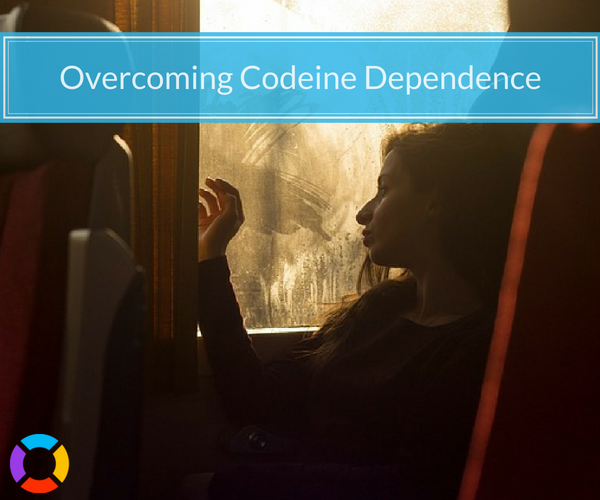Codeine Addiction, Withdrawal & Detox + Free 7-Day Recovery Guide

What is codeine, and how difficult is codeine detox? Codeine is an opioid that can treat mild pain and a persistent cough. Doctors prescribe it in tablets or cough syrups, sometimes combined with promethazine for added relief.
The Truth About Codeine
At first, you may see it as a safe, everyday medication. But codeine belongs to the opioid family. Codeine is a narcotic that alters brain chemistry and can lead to dependence.
With persistent use, tolerance grows over time, and the body demands more to feel the same effect.
What begins as symptom relief can quickly shift into a dangerous cycle of misuse and addiction, making early awareness essential. Codeine can feel safe, until it’s not. Here’s what you need to know.
Want to know more about codeine? Call now for help.
Codeine on the Street: Lean, Sizzurp & Schoolboy
On the street, codeine cough syrup goes by many names: Lean, Sizzurp, Purple Drank, Coties, and Schoolboy. You might be asking, “What is Lean drug?” Lean drug is typically made by mixing promethazine codeine cough syrup with soda and candy, creating a sweet, flavored drink.
This mix masks the medicinal taste but keeps the drug’s narcotic effects. Pop culture has glorified Lean effects. Some hip-hop artists and music videos have featured it as a symbol of status or relaxation.
This normalizes misuse, especially for younger audiences, while hiding its serious risks. You can overdose on Lean, especially when it’s used with other central nervous system depressants, like alcohol.
What Does Lean Do?
- Produces euphoria
- Causes drowsiness
- Slows breathing
- Impairs coordination
- Blurs vision
- Numbs pain
- Slows the heart rate
- Increases risk of overdose
How Codeine Affects the Brain and Body
You may have questions about the addictive properties of codeine. For example, why and how is codeine addictive?
Codeine is addictive because it activates the brain’s reward system. When taken, it binds to opioid receptors and triggers the release of dopamine, creating feelings of pleasure and relaxation.
Over time, the brain adapts, producing less dopamine naturally and relying on codeine to feel normal. This cycle drives cravings and dependence. As tolerance builds, you need higher doses for the same effect, increasing the risk of misuse and overdose.
Codeine changes how the brain and body respond to pain. The drug binds to opioid receptors, creating both physical and psychological codeine side effects. These effects vary depending on short-term or long-term use.
Long-term misuse rewires brain chemistry, making codeine addictive. Tolerance grows, misuse escalates, and the risk of overdose increases.
Short-Term Physical Effects
- Pain relief
- Cough suppression
- Drowsiness
- Slowed breathing
- Constipation
Short-Term Psychological Effects
- Euphoria
- Relaxation
- Reduced anxiety
- Mild confusion
Long-Term Physical Effects
- Tolerance—needing more for the same effect
- Respiratory problems
- Digestive issues
- Risk of overdose
Long-Term Psychological Effects
- Dependence and withdrawal symptoms
- Cravings
- Mood swings
- Impaired judgment
From Use to Abuse: Codeine Addiction
Codeine dependence means your body has adapted to the drug and needs it to avoid withdrawal. Codeine addiction goes further—it’s a compulsive need to use, even when it causes harm. When codeine cough syrup is used to make Lean, it can lead to Lean addiction.
Addicted to Lean? Call now for help.
Even people with legitimate prescriptions can slip into codeine misuse. As your tolerance builds, it can lead to using more frequently or at higher doses. This pattern can turn safe use into codeine abuse and dependence, leading to symptoms of codeine addiction.
Symptoms of Codeine Addiction
- Taking larger doses than prescribed
- Strong cravings for codeine cough syrup
- Needing it to function daily
- Ignoring work, school, or family responsibilities
- Hiding or lying about use
- Spending excessive time getting or using codeine
- Continued use despite health or legal problems
- Using Lean despite knowing the risks
Is Codeine Really That Dangerous?
Yes, codeine is a narcotic and a dangerous drug. Repeated use can pave the way to stronger drugs like morphine, heroin, fentanyl, and even carfentanil, which, like codeine, are opioids.
Even small amounts beyond the prescribed dose can overwhelm your body’s ability to process the drug. Because codeine is often taken in syrup form, it can be easy to underestimate how much you have taken.
The shift from casual use to life-threatening misuse can happen faster than you realize.
Can You Overdose on Codeine?
Yes, a codeine overdose can happen when you take too much at one time, especially after not using it for some time, and your tolerance has dropped.
On the other hand, as your tolerance builds, you may look for more powerful opioids to achieve the same effects. This progression also increases the risk of a fatal overdose.
This risk is even higher when codeine is mixed with alcohol, benzodiazepines, or other central nervous system depressants. The combination slows your breathing, lowers your heart rate, and causes extreme sedation, which can lead to coma or death.
What Happens When You Stop Using Codeine?
When you stop taking codeine, your body and mind can have distinct reactions called withdrawal. The withdrawal effects of codeine can feel like the worst flu you’ve ever had, alongside powerful cravings pulling you back toward using the drug. Lean withdrawal symptoms are similar.
The symptoms are your body’s way of adjusting after you’ve developed dependence. Knowing what to expect during codeine withdrawal helps you prepare and seek the right support to get through the process safely.
Physical Symptoms
- Nausea and vomiting
- Chills and sweating
- Runny nose and watery eyes
- Muscle aches and joint pain
- Stomach cramps and diarrhea
- Rapid heartbeat
- Restlessness
- Insomnia and fatigue
Mental Symptoms
- Anxiety and panic
- Depression and hopelessness
- Irritability and agitation
- Trouble concentrating
- Strong urges to use codeine or Lean
Timeline of Codeine Withdrawal
Codeine withdrawal symptoms typically begin within six to 12 hours after your last dose. Understanding the process is essential for a safe and successful recovery. Knowing what symptoms to expect and when they happen helps you prepare mentally and physically for the process.
Need help with codeine withdrawal? Call now.
Awareness reduces fear and lowers the risk of relapse. Having a clear plan in place helps you manage discomfort and focus on the next steps in your codeine recovery journey. The following outline provides details of what to expect in the first 10 days after your last codeine dose.
Phases of Codeine Withdrawal
The following are the phases of withdrawal you can expect during codeine dependence treatment. A structured codeine detox program understands these phases and manages each stage safely with prescription medication, helping to reduce the risk of relapse.
Free Tool: 7-Day Recovery Guide
For more information, check out our downloadable 7-Day Codeine Withdrawal Survival Plan.
Days 1–3
- Flu-like symptoms
- Muscle aches
- Runny nose
- Insomnia
- Anxiety
- Sweating
- Chills
- Nausea and vomiting
- Irritability
- Stomach pain
- Diarrhea
- Mood swings
- Intense craving (physical)
Days 4–7
- Digestive issues
- Mood swings
- Fatigue
- Brain fog
- Low motivation
- Lingering body aches
- Improving sleep
Days 8–10+
- Lingering fatigue and sleep issues
- Mood swings and/or depression
- Irritability
- Anxiety
- Trouble concentrating
- Cravings (psychological)
What Is Post-Acute Withdrawal Syndrome (PAWS)?
Post-acute withdrawal syndrome (PAWS) is a set of lingering withdrawal symptoms that can last for weeks or months after the initial codeine detox. While the intense physical symptoms fade within days, PAWS symptoms include ongoing mental and emotional effects.
These symptoms can include anxiety, depression, irritability, trouble concentrating, and sleep problems. These occur because your brain is still healing from the changes caused by long-term codeine use.
PAWS can make you feel vulnerable to relapse, which is why ongoing support, therapy, and relapse prevention strategies are essential during this stage of recovery.
Dangers of Detoxing at Home
Detoxing from codeine on your own can be dangerous. Without medical support, codeine withdrawal symptoms can lead to dehydration, extreme fatigue, and emotional distress. Cravings feel overwhelming, raising the risk of relapse within hours or days.
The greatest danger is overdose after a relapse. Once you stop using, your tolerance drops quickly. If you return to your previous dose of Lean or codeine cough syrup, an overdose is far more likely.
A professional codeine detox center offers 24/7 care, hydration support, and medications to ease withdrawal. Treatment for codeine addiction begins with detox but continues to address your emotional needs, lowering the chances of relapse. Codeine abuse treatment is the safest way to start your recovery.
You don’t have to suffer alone. Safe, professional detox is available 24/7.
What to Expect from Medical Detox
A medical codeine detox provides safe, supervised care to help you through withdrawal. In a professional codeine detox center, you’ll receive treatment for codeine addiction that addresses your physical symptoms and emotional needs.
Medications that may be used during a medical detox program include:
- Clonidine: Reduces anxiety, muscle pain, and other discomforts
- Buprenorphine: Eases cravings and is safer than methadone for many people
- Methadone: Controls severe withdrawals and can be used for long-term codeine addiction treatment
- Loperamide: Helps control diarrhea caused by withdrawal
- Ondansetron: Reduces nausea and vomiting
- Nonsteroidal anti-inflammatory drugs (NSAIDs): Relieve muscle and joint pain
- Hydroxyzine: Eases anxiety and helps with sleep during detox
However, while medication is very helpful during medical detox, evidence-based therapies are another important factor in treatment for codeine addiction. Therapies are crucial because they treat the physical dependence on codeine and the underlying emotional and behavioral patterns that drive addiction.
Therapies in codeine addiction treatment can include:
- Individual counseling: Helps you explore the roots of codeine misuse and build a recovery plan.
- Group counseling: Connects you with others who understand your struggles and with whom you can learn and share coping strategies.
- Coping tools: Prepares you for the next phase of recovery and lowers your relapse risk.
What Happens After Detox?
Detox is not recovery. However it is the first stage of codeine addiction treatment. Once your body is free from the drug the next step is addressing the mental, emotional and behavioral patterns behind codeine misuse.
You may transition into inpatient codeine rehab, outpatient programs or telehealth-based codeine rehabilitation. Each option has advantages and disadvantages, providing structure, therapy and accountability to help you build a strong foundation for codeine recovery.
Aftercare is as important as treatment. Support groups, relapse prevention strategies, 12 Step programs and ongoing therapy help maintain progress and reduce the risk of relapse.
Detox is just your first step. We’ll help you effectively plan rehab for codeine.
FAQs: Quick Answers to Urgent Questions
Lean is a drink made by mixing promethazine codeine cough syrup with soda and candy. It’s also called Purple Drank, Sizzurp, or Coties.
However, the question is, how addictive is Lean? The simple answer is very addictive. Since the sweet flavor masks the danger, it is easy to drink large amounts and quickly develop a habit.
Lean triggers addiction because it contains codeine, an opioid that changes your brain chemistry. Over time, your body needs more to feel the same effects.
Yes, codeine is an opioid, and most standard drug tests can detect it.
Urine tests may show codeine for up to three days after your last use, while blood tests detect it for a shorter period. Hair tests can reveal codeine use for up to 90 days. Detection times vary based on how much you use, how often you use it, and your body’s metabolism.
Codeine detox can last up to 10 days, but your detox timeline depends on how much and how often you’ve been using. Withdrawal symptoms often peak in the first two to four days.
You may experience lingering mental effects, like anxiety, insomnia, or cravings, for weeks. If you’ve been using Lean or codeine cough syrup heavily, your detox may take longer and require medical supervision to withdraw safely.
Quitting codeine cold turkey is possible, but it is not advisable since it can be intense and risky. Stopping suddenly triggers strong withdrawal symptoms that are difficult to manage on your own.
If you’ve been using codeine cough syrup, Lean, or high doses for a long time, medical supervision makes detox safer. A professional detox program reduces withdrawal effects and lowers the risk of relapse.
Many insurance plans cover codeine detox, especially when it’s medically necessary. Coverage can include inpatient or outpatient detox programs, medications to ease withdrawal, and follow-up care.
However, the specifics depend on your provider, policy, and state regulations. Always check with your insurance company to confirm what’s included and whether prior authorization is required.
No, hydrocodone and codeine are two different opioid medications. Both treat pain and cough, and both can be addictive, but they are separate drugs.
Hydrocodone is a semi-synthetic drug, while codeine occurs naturally in the opium poppy. A prescription for hydrocodone does not contain codeine, but both carry similar risks for dependence, misuse, and overdose.
Codeine usually stays in your system for up to three days, but detection times vary by test type. Urine tests can detect codeine for up to 48–72 hours after your last dose.
Blood tests typically detect it for up to 24 hours, while saliva tests can show it for 24 to 96 hours. Hair tests may detect codeine for up to 90 days. Factors like your metabolism, dosage, frequency of use, and whether you’ve been using Lean or codeine cough syrup affect how long it remains in your body.
Find Help Now: Start Codeine Detox Today
You don’t have to face codeine withdrawal alone. A professional codeine detox center offers affordable, confidential, and safe care, often covered by your health insurance benefits. With the right codeine addiction treatment, you can begin recovery in a supportive, judgment-free environment.
Download our 7-Day Codeine Withdrawal Survival Plan for more information.
From your first day in detox to your transition into codeine rehab, you’ll have a team guiding each step of your treatment for codeine addiction. We encourage you to take the first step toward a healthier future.
Call now or browse detox centers near you.



